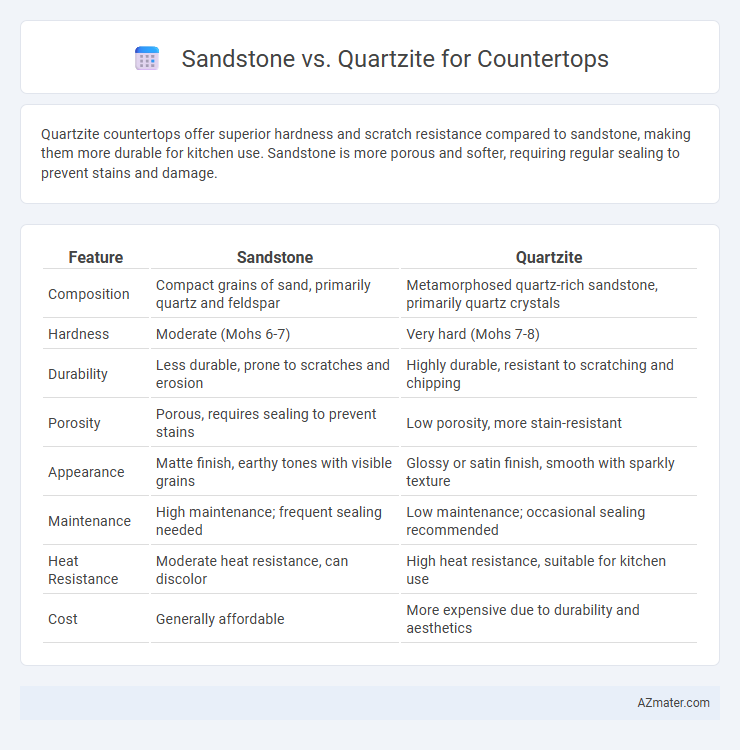Quartzite countertops offer superior hardness and scratch resistance compared to sandstone, making them more durable for kitchen use. Sandstone is more porous and softer, requiring regular sealing to prevent stains and damage.
Table of Comparison
| Feature | Sandstone | Quartzite |
|---|---|---|
| Composition | Compact grains of sand, primarily quartz and feldspar | Metamorphosed quartz-rich sandstone, primarily quartz crystals |
| Hardness | Moderate (Mohs 6-7) | Very hard (Mohs 7-8) |
| Durability | Less durable, prone to scratches and erosion | Highly durable, resistant to scratching and chipping |
| Porosity | Porous, requires sealing to prevent stains | Low porosity, more stain-resistant |
| Appearance | Matte finish, earthy tones with visible grains | Glossy or satin finish, smooth with sparkly texture |
| Maintenance | High maintenance; frequent sealing needed | Low maintenance; occasional sealing recommended |
| Heat Resistance | Moderate heat resistance, can discolor | High heat resistance, suitable for kitchen use |
| Cost | Generally affordable | More expensive due to durability and aesthetics |
Understanding Sandstone and Quartzite
Sandstone is a sedimentary rock composed mainly of sand-sized mineral particles, often calcium carbonate or quartz, valued for its rustic appearance but relatively softer surface. Quartzite originates from sandstone through intense heat and pressure, transforming it into a dense, hard metamorphic rock known for its durability and resistance to scratches and heat. Understanding these differences highlights quartzite's superior strength for countertops, while sandstone offers unique textures but requires more maintenance and sealing.
Formation and Composition Differences
Sandstone forms from compacted sand grains cemented by minerals like silica, calcite, or iron oxides, resulting in a sedimentary rock with visible layers and a softer texture. Quartzite originates from the metamorphism of quartz-rich sandstone, where intense heat and pressure recrystallize quartz grains into a dense, interlocking structure, creating a highly durable and hard stone. This fundamental difference in formation gives quartzite superior hardness and resistance to abrasion compared to the more porous and less resilient sandstone.
Appearance and Color Variations
Sandstone countertops feature a natural, earthy appearance with warm tones ranging from beige and tan to rusty reds and browns, often displaying distinct layering and grain patterns. Quartzite offers a more polished, marble-like look with a broader color palette, including whites, grays, blues, and subtle veining that adds elegance and brightness to kitchen or bathroom designs. Both materials provide unique aesthetic appeal, but quartzite tends to have more vibrant color variations and a smoother, reflective finish compared to the matte, rugged texture of sandstone.
Durability and Hardness Comparison
Quartzite countertops exhibit superior durability and hardness compared to sandstone, ranking around 7 on the Mohs scale while sandstone typically falls between 6 and 7. Quartzite's dense, interlocking quartz crystals make it highly resistant to scratches, heat, and etching, ideal for high-traffic kitchen surfaces. Sandstone, being more porous and softer, requires sealing and careful maintenance to avoid damage and staining, making it less suitable for heavy-use countertops.
Maintenance Requirements
Sandstone countertops require regular sealing due to their porous nature, which makes them susceptible to staining and water damage. Quartzite, being denser and harder, demands less frequent sealing and offers superior resistance to scratches and heat. Both materials benefit from gentle cleaning with non-abrasive cleaners to maintain their surface integrity and prolong their lifespan.
Resistance to Stains and Scratches
Quartzite countertops exhibit superior resistance to stains and scratches compared to sandstone, due to quartzite's dense and hard crystalline structure. Sandstone, being softer and more porous, is prone to absorb liquids and is more susceptible to surface abrasion and etching. For long-lasting durability and minimal maintenance in kitchen environments, quartzite is the preferable choice over sandstone.
Heat and Chemical Resistance
Quartzite countertops exhibit superior heat resistance, often withstanding temperatures up to 1,200degF without damage, making them ideal for kitchens with frequent hot cookware use. Sandstone, being softer and more porous, tends to absorb heat and is more susceptible to etching or discoloration when exposed to acidic chemicals or high heat. Choosing quartzite ensures a durable surface resistant to heat and chemical wear, whereas sandstone requires more careful maintenance to prevent damage from everyday kitchen activities.
Installation Considerations
Quartzite countertops require professional installation due to their extreme hardness, which makes cutting and shaping challenging without specialized tools. Sandstone, being softer and more porous, allows for easier cutting and handling but demands thorough sealing to prevent staining and damage during and after installation. Proper surface preparation and the use of suitable adhesives are critical for both materials to ensure durability and a secure fit in countertop applications.
Cost: Sandstone vs Quartzite
Sandstone countertops generally cost less than quartzite, with prices ranging from $30 to $60 per square foot compared to quartzite's $70 to $120 per square foot. The lower cost of sandstone is due to its softer composition and more abundant availability, while quartzite's high cost reflects its durability and resistance to scratches and heat. Homeowners seeking budget-friendly options often choose sandstone, but those prioritizing long-term investment and durability typically prefer quartzite despite the higher initial expense.
Choosing the Right Material for Your Countertop
Sandstone offers a unique, natural aesthetic with warm tones and a softer surface, making it ideal for low-traffic countertops that require a rustic appeal. Quartzite provides superior hardness and resistance to heat, scratches, and stains, making it a durable choice for high-use kitchen countertops needing longevity and minimal maintenance. Selecting between sandstone and quartzite depends on balancing aesthetic preference with functional demands, prioritizing quartzite for durability and sandstone for distinctive visual texture.

Infographic: Sandstone vs Quartzite for Countertop
 azmater.com
azmater.com